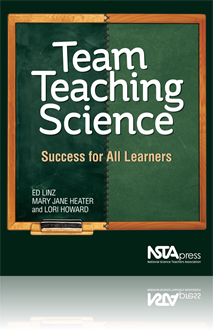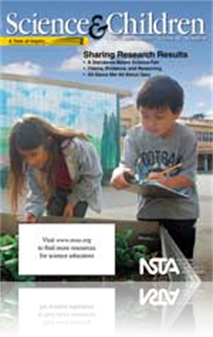All Resources
Book Chapter
Teaching Science: The Instruction
Teaching science has unique challenges and opportunities for the co-teaching team. Science can be taught with a hands-on approach that encourages students to explore concepts and ideas through interaction. Science lessons can also use simulations or ...
Book Chapter
In this chapter, the importance of communication on a variety of topics is discussed. Each co-teaching team is unique and will have differing preferences for how to establish their working relationship. A good co-teaching relationship is an exciting ...
Book Chapter
Team Teaching: Science in the Elementary Classroom
Many of the challenges of team teaching—such as communication, content knowledge, and joint instruction—are issues that all co-teachers must address; however, there are unique characteristics to the elementary classroom that must be navigated by ...
Book Chapter
Team Teaching: Science in the Middle School Classroom
Co-teachers in science at the middle school level must address co-teaching issues as well as the unique challenges of instructing middle school learners. Middle school is just that—in the middle, between elementary school and high school. Middle sc...
Book Chapter
A Team-Teaching Game Plan for One School Year
This chapter helps to outline what all co-teaching teams should be doing during each phase of a typical school year. Because the two individuals involved in co-teaching are operating in a situation in which there must be teamwork, the authors recomme...
Book Chapter
Teaching Science to Students With Special Needs in Advance Classes
Most advanced science classes are not team taught. Although there may be several students with special needs in honors, gifted and talented, International Baccalaureate (IB), or Advanced Placement (AP) science classes, classroom instruction is typica...
NSTA Press Book
Team Teaching Science: Success for All Learners
In Team Teaching Science, Ed Linz, Mary Jane Heater, and Lori A. Howard demonstrate the truth in the old adage “Two heads are better than one.” This guide for developing successful team-teaching partnerships that maximize student learning will h...
By Lori A. Howard, Ed Linz, Mary Jane Heater
Book Chapter
Science and Art: Dueling Disciplines or Dynamic Duo?
A mixer activity (supplemented by “scientific” art, music, and optional demonstrations) is used to catalyze a conversation on the similarities and differences between the sciences and the arts. ...
Book Chapter
5 E(z) Yet pHenomenal Steps to Demystifying Magic Color-Changing Markers
In this chapter you will explore, the chemical principles that explain the “science behind the magic” of color changing markers are explored in a series of teacher-guided but learner-designed hands-on explorations....
Book Chapter
5 E(z) Steps Back Into “Deep” Time: Visualizing the Geobiological Timescale
In this chapter, you will explore a sequence of fun, participatory activities juxtapose everyday popular culture and human time perspectives with the geobiological timescale of Earth’s history of millions and billions of years. The overall timesca...
Book Chapter
5 E(z) Steps to Earth-Moon Scaling: Measurements and Magnitudes Matter
Learners are surprised to learn that most textbook illustrations incorrectly represent the relative sizes and/or distance between Earth and its single moon. Although these and other visual representations of our solar system “lie” or grossly misr...
Book Chapter
Acronyms and Acrostics Articulate Attributes of Science (and Science Teaching)
Learners’ ideas about the nature of science, school science, and science teaching are elicited by their creation of acronyms or acrostics that define key characteristics of science and teaching. An Extension activity provides discussion questions f...
Book Chapter
Tackling the Terrible Tyranny of Terminology: Divide and Conquer
Big, hard words in science are invariably made up of small, easy Greek- and Latin-based prefixes, suffixes, and root words that students can systematically learn, continually use, and creatively recombine. An unusually long science word; a simple (...
Book Chapter
Inquiring Into Reading as Meaning-Making: Do Spelling and Punctuation Really Matter?
Learners are asked to read a passage full of misspelled words. Many readers are able to discern the meaning despite the numerous intentionally embedded errors. In a second exercise, learners experience how the meaning of a passage can be dramatically...
Book Chapter
Ambiguous Text: Meaning-Making in Reading and Science
Learners are asked to read one or more passages of ambiguous, discrepant text where they understand the individual words (or “trees”) but are hard-pressed to connect the words with an overall context (or “forest”) to extract and construct mea...
Book Chapter
Glue Mini-Monster: Wanted Dead or Alive?
A drop of clear, colorless, viscous liquid (i.e., a specific brand of modeling glue) assumes the role of an unknown macroscopic, single-celled organism in this demonstration. When placed in a petri dish of water, it is observed to move and interact ...
Book Chapter
Water “Stick-to-It-Ness”: A Penny for Your Thoughts
Water (in contrast to other clear, household liquids) assumes and maintains a very distinct semispherical shape when placed on a piece of waxed paper. For related reasons, a discrepantly large number of drops of water can be placed on top of a penny...
Book Chapter
Burdock and Velcro: Mother Nature Knows Best
In this chapter’s activity, Velcro is explored as an example of a human-engineered invention that was a “copycat” inspired by a naturally evolved, “bio-engineered” seed distribution innovation....
Book Chapter
Book Chapter
Greenhouses are made almost completely of glass for two reasons. First, glass allows the maximum amount of sunlight into the building. Plants need the sunlight for photosynthesis. Second, glass prevents heat produced in the greenhouse from escaping....
NSTA Press Book
Even More Brain-Powered Science: Teaching and Learning With Discrepant Events
• How can water and a penny demonstrate the power of mathematics and molecular theory? • Do spelling and punctuation really matter to the human brain? ...
By Thomas O'Brien
Journal Article
Promote better eating habits by examining the role of plants in students' diets. Students learn about biodiversity, monocultural agriculture, dangers to the food supply, and the potential power and safety of biodiverse food systems....
Journal Article
Earth's Most Important Producers: Meet the Phytoplankton!
Students learn about single-celled, plantlike organisms called phytoplankton, which are the base of nearly all marine food webs. During the lesson students construct and use a phytoplankton net and create a phytoplankton bloom in the classroom....
Journal Article
The Green Room: What's in Your Trash?
Each year, Americans generate 250 million tons of waste, recycle or compost about 33% of it, and dispose of most of the rest in landfills (EPA 2009). Though recycling has increased in the United States since 1980, waste generation has increased along...
Journal Article
Guest Editorial: What a copper-plated nail taught me about sharing research results
Linda Shore relives the first time she shared the results of a science experiment....
Journal Article
From Misconceptions to Conceptual Change
We all have misconceptions about the world in which we live—how it works, how we interact with it, how it changes, and the reasons behind those changes. These misunderstandings are personal notions we create to make meaning of our surroundings. Oft...
Journal Article
Scope on the Skies: A Planetpalooza
This column focuses on astronomy throughout the year. This month’s column discusses planet viewing and space flights....
Journal Article
The Early Years: Sharing Research Results
Students collect data about the qualities of various play doughs. ...
Journal Article
Science 101: How does a lever work?
Two approaches to how a lever works: one dealing with torque, one dealing with energy....
Journal Article
PD Pathways: Have a Kids Inquiry Conference
Encourage students to develop their own inquiry projects, carry them out using an inquiry-based model, and prepare for a public sharing event....
Journal Article
Editor's Roundtable: Words to Grow On
Science Scope’s editor shares thoughts regarding the current issue....
Journal Article
Guest Editorial: Biodiversity and the Future of Food
The author discusses biodiversity and the future of food....










